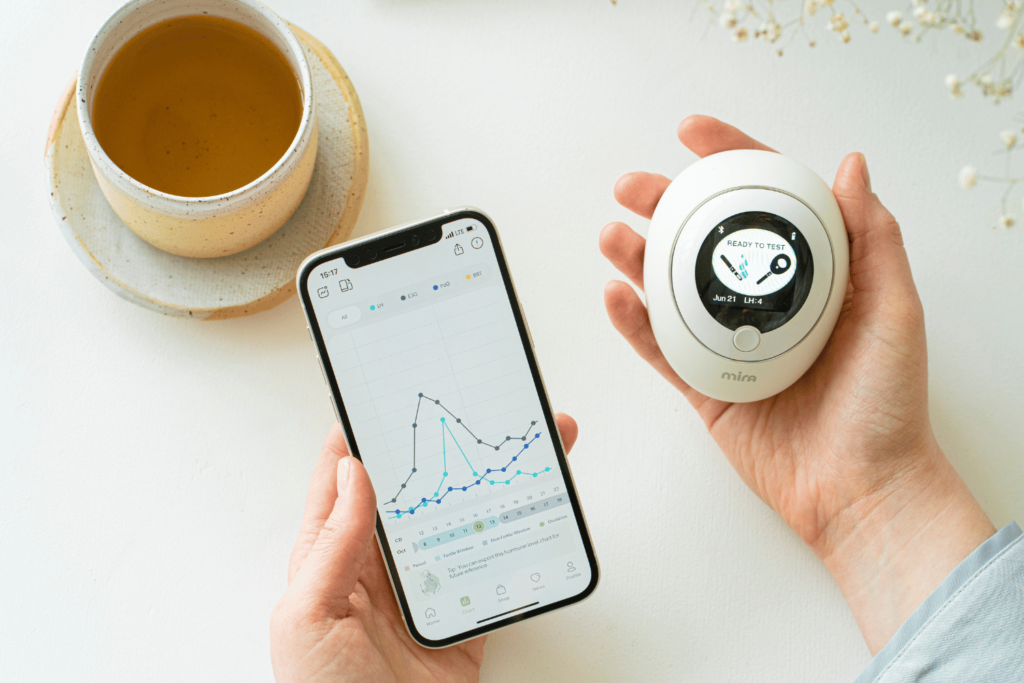Ovulation Calculator
Get to know your menstrual cycle better with this handy ovulation calculator!
This conception calculator is designed to help you estimate key dates of your cycle – such as your fertile window, estimated day of ovulation, and the estimated day of your next period. It can also help you to pinpoint the first day you can take a pregnancy test if you are trying to conceive (TTC).
A More Accurate Way to Track Ovulation: Introducing the Mira App and Analyzer
The most accurate way to anticipate your fertile window and predict ovulation is by measuring and tracking your fertility hormones directly.
Traditionally, this had to be done with frequent visits to the doctor’s office, but today, this can be done from the comfort of your home with Mira’s at-home hormone monitoring system – a palm-sized hormone lab that can provide you with real-time fertility hormone data.

What can Mira measure?
Mira can measure the following four key sex hormones in urine:
- Luteinizing hormone (LH) to predict ovulation and fertile window
- Estrone-3-glucuronide (E3G) to predict ovulation and fertile window
- Pregnanediol glucuronide (PdG) to confirm ovulation*
- Follicle-stimulating hormone (FSH) to understand fertility status
When these hormones are tracked consistently over time, Mira can predict an individual’s fertile window and day of ovulation with up to 99%** accuracy.
How does Mira work?
Mira utilizes high-precision fluorescent detection technology – similar to what is used in professional laboratories.

All you have to do is dip one of our Mira testing wands into a urine sample for 20 seconds, insert the wand into the Mira Analyzer, and wait 21 minutes to receive your results.Once your results are ready, they are then synced and charted with the Mira App where you can see a full picture of your fertility – including how your hormones have changed over time, your estimated day of ovulation, and your fertility window. Over time, Mira’s advanced AI technology (trained on over 13M hormone data points and 950,000 menstrual cycles) learns even more about your cycle; providing you with increasingly accurate results with each test. Take an extra inside look into how Mira works.
What is Ovulation
If you have just started your fertility journey, it might be helpful for us to recap what exactly ovulation is, and why tracking it is so important for planning a pregnancy.
First things first: ovulation is a biological process that occurs when an egg is released from the ovaries. It typically happens midway through the menstrual cycle – however, the exact timing of ovulation varies greatly among individuals. Without ovulation, pregnancy is not possible.
Individuals have the highest chances of getting pregnant in the days leading up to ovulation and the day of ovulation – a period of time known as the ‘fertile window’. This is why tracking ovulation is key for those who are TTC.
How fertile days are calculated
Ovulation calculators often use a formula based on the calendar or “rhythm” method of family planning. This formula takes into account the first day of an individual’s last period and the average number of days in their cycle. This information can then be used to estimate the upcoming day of ovulation and fertile window.
For example, in a standard 28-day cycle, ovulation date typically occurs on day 14 (i.e. 14 days after the start of a period). Because fertile windows (on average) start around five days before ovulation date and end 24 hours after ovulation, this means that the fertile window in this scenario would start on day 10 and end on day 15.
It’s also common for ovulation or conception calculators to utilize the Standard Days Method (SDM) to predict ovulation. This method can be used to identify a 12-day fertile window and build your own fertility calendar. However, it only works for individuals whose average menstrual cycle length is between 26 to 32 days.
Limitations of ovulation calculators
Unfortunately, ovulation calculators do have some limitations. This is because their formulas are based on global averages – meaning they cannot accurately predict ovulation for individuals with irregular cycles or those with longer than average (more than 32 days) or shorter than average (less than 26 days) cycles. They are also not an appropriate tool for individuals with hormonal conditions such as PCOS (polycystic ovarian syndrome).
In essence, conception calculators should only be used if your cycle is perfectly consistent in terms of length and timing. If it’s not, it’s a good idea to explore other, more personalized, alternatives for tracking ovulation.
Ovulation signs and symptoms
The physical signs and symptoms of ovulation include:
- Fluctuating hormones (most notably luteinizing hormone, estrogen, and progesterone)
- Changes in cervical mucus and cervical positioning
- Pain and/or cramping in the lower abdomen
- Increased libido
- Changes in BBT (Basal Body Temperature)

Other signs of ovulation include changes in saliva, breast tenderness, headaches, spotting, and nausea.
Many of these symptoms can be monitored and tracked in order to predict ovulation. However, not all symptoms or tracking methods are necessarily reliable, with many tracking methods requiring months of meticulous tracking before they can be used as a reliable tool to predict ovulation.
This is why over 100,000 people have chosen Mira to guide their fertility journey. It takes the guesswork out of predicting ovulation; helping individuals get pregnant as efficiently as possible.
When can I get pregnant?
It is possible to get pregnant anytime during your cycle. However, you are the most likely to get pregnant during your fertile window. The typical fertile window begins five days before ovulation and lasts until 24 hours after ovulation.
If you are actively TTC, you should aim to have sex at least once every other day during your fertile window to increase chances of getting pregnant.
If you are postponing pregnancy, fertility specialists often recommend avoiding sex (or making sure to use protection) at least two days before your fertile window, during your fertile window, and during the two days after your fertile window.
More TTC Help From Mira
At Mira, we want nothing more than to help you achieve your fertility goals. If you are actively trying to plan a pregnancy, check out our other products that can support you!
Fertility Supplements
Boost your fertility wellness and help keep your hormones balanced naturally with our prenatal vitamin supplements – formulated by our fertility experts.
Hormone Health Clinic for Fertility
An integrative (whole-body) program focused on improving your natural conception journey and hormonal health. Our expert Fertility Coaches offer personalized support, tackling often-neglected areas like hormonal balance, nutrition, and stress management.

A little extra support from an expert can go a long way
Book an online consultation with one of our Hormone Health Coaches.
Schedule NowPanorama Fertility Lab Test
Learn more about your reproductive health status by taking our Panorama Fertility Lab Test. Once tested, you’ll receive five personalized hormone reports with insights on your ovarian reserve, thyroid function, menstrual cycle, and overall fertility health.
Fertility-friendly lubricant
Have sperm-friendly sex with the help of BioGenesisTM Fertility Lubricant – it’s paraben-free, water-based, and hypoallergenic.
Guided TTC Course
Kickstart your fertility journey with our Guided TTC Course, featuring world-renowned doctors, fertility experts, and real-life moms who have been in your shoes.
Basal Body Thermometer
Understand your body’s natural rise and fall in temperature throughout your menstrual cycle with our Basal Body Thermometer – the perfect companion for tracking ovulation in the Mira App.
Final Thoughts
We want to empower you to learn everything you can about your body and the TTC process. In addition to our free ovulation calculator and app, we invite you to explore our library of helpful blog articles and ebooks. You are also welcome to join our support group on Facebook!
*Please note that Progesterone (measured in ng/mL) should not be confused with PdG (measured in ug/mL) the urine metabolite of progesterone commonly used in at-home testing. Mira tracks PdG only.
**According to an internal Mira study. Copy of the study available upon request.
Mira’s Editorial Process
All content produced by Mira meets stringent editorial standards, ensuring excellence and accuracy in language and medical precision. Every piece undergoes thorough fact-checking and review by qualified professionals. Check out our full editorial process to learn more.


 Back
Back


